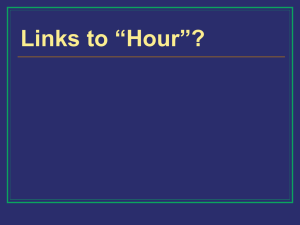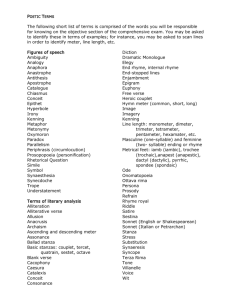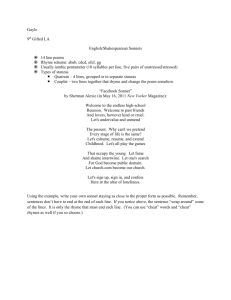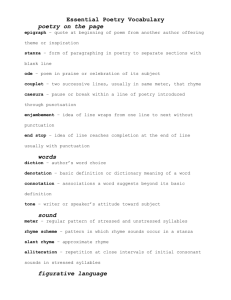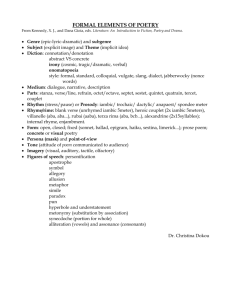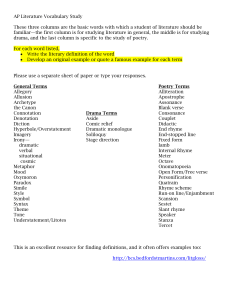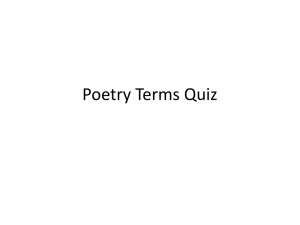Poetry Devices AP Exam Review - coppola
advertisement
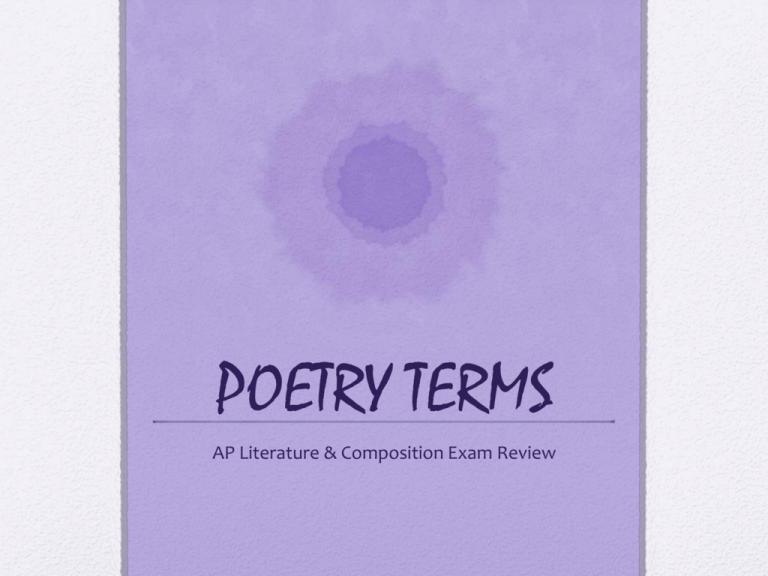
POETRY TERMS AP Literature & Composition Exam Review •Alliteration Alliteration •Repeated consonant sounds at the beginning of words placed near each other, usually on the same or adjacent lines. •Example: fast and furious •Assonance Assonance Repeated vowel sounds in words placed •near each other, usually on the same or adjacent lines. •Example: bruise/lose Example: neigh/fade • •Consonance Consonance • Repeated consonant sounds at the ending of words placed near each other, usually on the same or adjacent lines. This produces a pleasing kind of near-rhyme. • Example: boats into the past • Example: cool soul •Cacophony Cacophony • A discordant series of harsh, unpleasant sounds helps to convey disorder. This is often furthered by the combined effect of the meaning and the difficulty of pronunciation. • Example: My stick fingers click with a snicker And, chuckling, they knuckle the keys; Lightfooted, my steel feelers flicker And pluck from these keys melodies. —“Player Piano,” John Updike •Euphony Euphony • A series of musically pleasant sounds, conveying a sense of harmony and beauty to the language. • Example: Than Oars divide the Ocean / Too silver for a seam— Or Butterflies, off Banks of Noon Leap, splashless as they swim. — “A Bird Came Down the Walk,” Emily Dickenson (last stanza) •Synesthesia Synesthesia • An attempt to fuse different senses by describing one kind of sense impression in words normally used to describe another. • Example: The sound of her voice was sweet. • Example: a loud aroma, a velvety smile •Allusion Allusion •A brief reference to some person, historical event, work of art, or Biblical or mythological situation or character. •Apostrophe Apostrophe • Speaking directly to a real or imagined listener or inanimate object; addressing that person or thing by name. • Example: O Captain! My Captain! our fearful trip is done... •Connotation Connotation • The emotional, psychological or social overtones of a word; its implications and associations apart from its literal meaning. Often, this is what distinguishes the precisely correct word from one that is merely acceptable. •Denotation Denotation •The dictionary definition of a word; its literal meaning apart from any associations or connotations. •Euphemism Euphemism • An understatement, used to lessen the effect of a statement; substituting something innocuous for something that might be offensive or hurtful. • Example: She is at rest. (meaning, she’s dead) •Metonymy Metonymy • A figure of speech in which a person, place, or thing is referred to by something closely associated with it. • Example: The White House stated today that... • Example: The Crown reported today that... • Example: Wall St. walked off with most of our savings. •Oxymoron Oxymoron • A combination of two words that appear to contradict each other. • Example: a pointless point of view; bittersweet •Paradox Paradox • A statement in which a seeming contradiction may reveal an unexpected truth. • Example: The faster I go the more behind I get. •Synecdoche Synecdoche • Indicating a person, object, etc. by letting only a certain part represent the whole. • Example: All hands on deck. • Example: using “wheels” to mean a car • Example: referring to violins, violas, cellos, and basses as “the strings” •Enjambment Enjambment • The continuation of the logical sense — and therefore the grammatical construction — beyond the end of a line of poetry. This is sometimes done with the title, which in effect becomes the first line of the poem. •End Rhyme V. •Internal Rhyme End Rhyme v. Internal Rhyme • End Rhyme – rhyme that occurs at the end of lines of poetry • Example: Her voice, soft and lovely when she sings, Came to me last night in a dream. In my head her voice still rings, How pleasant last night must seem. • Internal Rhyme – a rhyme occurring within a line of poetry • Example: Once upon a midnight dreary, while I pondered weak and weary… •Open Form Open Form • Poetic form free from regularity and consistency in elements such as rhyme, line length, and metrical form • Free Verse – lines with no prescribed pattern or structure – poet determines all the variables as seems appropriate for each poem •Closed Form Closed Form •poetic form subject to a fixed structure and pattern •Blank Verse Blank Verse •unrhymed iambic pentameter •Couplet V. •Heroic Couplet Couplet v. Heroic Couplet •Couplet: a pair of lines, usually rhymed; this is the shortest stanza •Heroic Couplet: a pair of rhymed lines in iambic pentameter •Stanza Stanza • group of lines in the formal pattern of a poem • Types of stanzas include: • Couplet – two rhymed lines, shortest stanza • Tercet – three lines, usually with the same rhyme • Quatrain – four lines • Cinquain – five lines • Sestet – six lines • Octave – eight lines •Elegy Elegy •a formal poem focusing on death or mortality, usually beginning with the recent death of a particular person •Idyll Idyll •a short, descriptive narrative, usually a poem, about an idealized rural life •also called a pastoral •Lyric Poetry Lyric Poetry • Melodious, imaginative, and subjective poetry that is usually short and personal, expressing the thoughts and feelings of a single speaker rather than telling a story •Ode Ode •A lyric poem, usually serious and elevated in tone, often written to praise someone or something •Sonnet Sonnet • a fourteen-line poem in iambic pentameter with a prescribed rhyme scheme; its subject was traditionally love • Three variations are found frequently in English, although others are occasionally seen. •Shakespearean Sonnet Shakespearean Sonnet •a style of sonnet used by Shakespeare with a rhyme scheme of abab cdcd efef gg •Italian (Petrarchan) Sonnet Italian (Petrarchan) Sonnet •a form of sonnet made popular by Petrarch with a rhyme scheme of abbaabba cdecde (or cdcdcd) •Spenserian Sonnet Spenserian Sonnet •a variant of the Shakespearean form in which the quatrains are linked with a chain or interlocked rhyme scheme: abab bcbc cdcd ee •Villanelle Villanelle • poem of 19 lines • 5 tercets (3-line stanzas) followed by a quatrain • 1st line of the 1st tercet is repeated as the last line of the 2nd & 4th tercets • 3rd line of the 1st tercet is repeated as the last line of the 3rd & 5th tercets • 2 refrain lines are repeated as a couplet in the last 2 lines of the quatrain • rhyme scheme is aba aba aba aba aba abaa • gradually builds in tone and intensity
